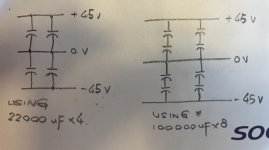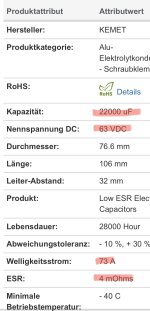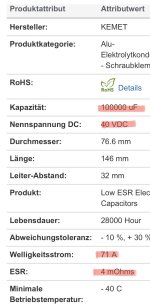I am building a Power supply for my amplifier, intend to have +- 45Vdc, approx. 100000uF filter capacitance using KEMET PEH169 series capacitors. I have the choice of:
1) using 22000uF, 63V, ripple current = 73A, ESR 4mOhms capacitor x 4 = 88000uF
2) using 100000uF, 40V, ripple current = 71A, ESR 4mOhms capacitor x 8 = 200000uF (with every pair of capacitors connected in series)
Cost of solution 1 and 2 are about the same.
For solution 2, even though the effective capacitance is more than double, by connecting the capacitors in series would the ESR also doubled, hence ripple current became half too?
Could experts shed some lights on which solution is preferred?
Thank you
1) using 22000uF, 63V, ripple current = 73A, ESR 4mOhms capacitor x 4 = 88000uF
2) using 100000uF, 40V, ripple current = 71A, ESR 4mOhms capacitor x 8 = 200000uF (with every pair of capacitors connected in series)
Cost of solution 1 and 2 are about the same.
For solution 2, even though the effective capacitance is more than double, by connecting the capacitors in series would the ESR also doubled, hence ripple current became half too?
Could experts shed some lights on which solution is preferred?
Thank you
Attachments
Thanks!
So ripple current is half, hence the “performance” of solution 2 in dynamic situations is not as good as solution 1, even though the overall capacitance is more than doubled?
What about the energy (1/2CVe2), stored energy for solution 2 is more than double that of solution 1, how would that has an effect on sound quality?
So ripple current is half, hence the “performance” of solution 2 in dynamic situations is not as good as solution 1, even though the overall capacitance is more than doubled?
What about the energy (1/2CVe2), stored energy for solution 2 is more than double that of solution 1, how would that has an effect on sound quality?
Esr limit max current, which capacitors can surge and output to load , when voltage from winding is lower and diode bridge is not conducting. If i'm understanding right, one type capacitor is for higher voltage, other type for lower, but same esr?
So then it's better to have higher voltage version in parralel, this will decrease esr and double allowed current for capacitor bank.
Also, series connected capacitors usually do not share the voltage equally, as expected in theory. However, for low current applications (e.g. SMPS front end), it is possible to use a pair of high value resistors to force the the voltage to split more or less equally, without much problem.
I intend to drive electrostatic speakers, nominal 6 Ohm, lowest 1.5 Ohm.How much capacitance do you need? i.e. what is the speaker load resistance you intend to drive?
I started with thinking about 100,000uF, but realised that I could have 200,000uF at the same cost, but with double ESR, hence lower ripple current, which appears to be defeating the purpose of having higher capacitance, but with higher capacitance the ripple voltage will be lower, and the stored energy doubled.
I am not sure in practice how ripple current, stored energy and ripple voltage affect sonic performance. Should I sacrifice ripple voltage and stored energy for better ripple current? Or vice versa?
How much capacitance would you suggest?
Yes, and each 100,000uF, 40V is taller than 22,000uF, 63V. So it is more than double the space, but I do have the space for it.Of course 8 capacitors will take up twice the space.
I am not sure in practice how ripple current, stored energy and ripple voltage affect sonic performance. Should I sacrifice ripple voltage and stored energy for better ripple current? Or vice versa?series capacitors are a last resort means imho....only when you have no other choice...
- Home
- Amplifiers
- Power Supplies
- Connecting capacitors in series


